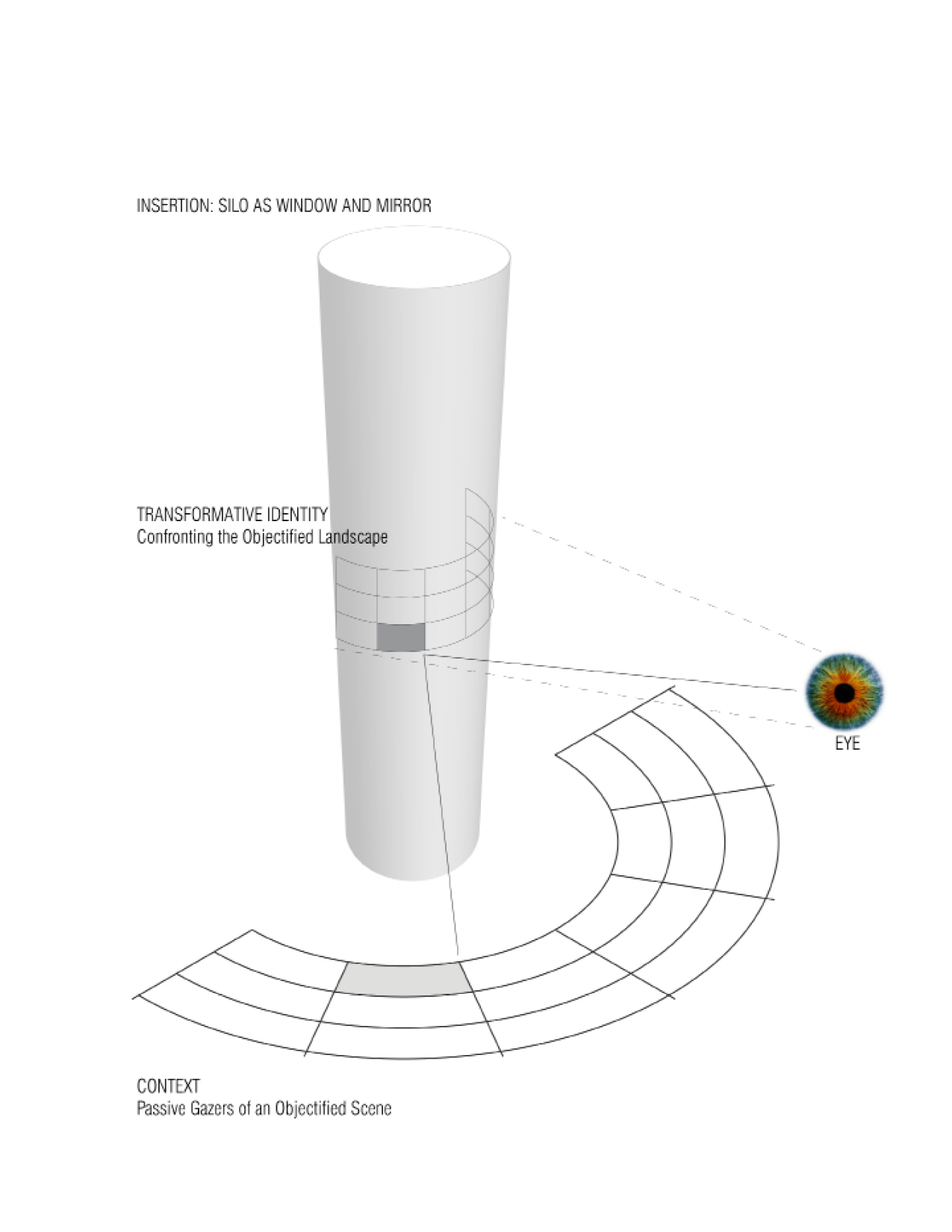Stored Potential - “Insertion”
Omaha, NB
“Insertion: highlighting a condition between seeing and being seen”
As we pass, we may be addressed by this inanimate object – the silo. One object amongst many that strives to define itself and its function with the precision that is a part of its nature. It has no preconceptions because it is without memory or ability to reason. It is silent in its objectivity and incapability of emotional response. Inserting itself adjacent, nearly bridging the interstate of Omaha, the forgotten architecture of past days meditates on the surrounding landscape, faithfully reproducing its colors and design until darkness reigns. These happenstances recur with potent regularity but are lost within a vast and ambivalent landscape. An attempt to return our image of landscape to its former ‘aspect ratio’ is to begin to understand where it is we have arrived, and where we wish to take it.
As the 72,000+ people pass this agricultural threshold each day there is a complacency that develops with its familiarity - a diminished and hidden image of the larger purpose these hulking pieces of urban infrastructure once served. Simultaneously, they are a testament to the progress they enable, and an icon of a landscape - forgotten. Repurposing this banal yet imposing façade requires bold measures that seek to bring to light their understated contribution to, and interrelatedness with our daily lives. More than just storage for bulk materials, they are the gatekeepers of all that emerges around them – the “stored potential” that continues to provide us with that which we both take for granted and relinquish our control to.
Catoptric anamorphosis – communication traditionally revealed through a process of greatly distorting an image only to have it revealed either from a single vantage point or from its reflection on a mirrored surface - is the inspiration and basis for this intervention. Our distorted image here, however, surrounds us - a constructed and historically layered landscape that provides accompaniment to the iconic silo structures. Rather than mere graphic representation, achieving enlightenment of this landscape’s “collective autobiography” is attempted through the use of a mirror (or metallized film surface) draped upon the silo’s existing cylindrical structure - the most common form of anamorphic art. The subsequent surprise and memorable appearance of the undistorted reflection or image will be met with wonder and delight.
The installation’s insertion into the landscape is intended to foreground the world around it that is already present but not apparent - encouraging full-length representation and conscious penetration. With the ability to manipulate space or simply make it disappear, the installation doubles as a window looking toward the world beyond, at the same time providing a stark reflection of the world from which it receives its gaze. As the mirror bulges outward at the center, light rays seem to come from behind the mirror and its reflections appear smaller and further away. An irony abounds as the structure recalls the optics of a car’s rear-view mirror, providing a metaphorical interplay on the passer-by. The silo springs to life as a performance art piece that soon forces us to confront ourselves and our influence within and upon the surrounding landscape. Confronted by our reflected realities we may read our history and catch a glimpse of energy in action, working its magic on light and the land that buzzes around it.
Competition Site (proposed installation shown)
competition brief
In Omaha, 50+ vacant concrete silos located on Vinton Street at the juncture of I-80 and I-480 comprise the most iconic elevator in the city. This landmark structure occupies a
visible location seen daily by over 76,000 vehicles, borders a residential neighborhood, is the southern terminus of the crosstown Field Club Trail and several of the silos are being used as rock climbing walls.
The Stored Potential mural project will re-purpose the relic’s exterior by inviting creative designs for 20’ x 80’ banners to cover one side of a silo. Images will be selected based on context, originality, larger scope of vision and how individual panels combine with one another to form a new façade that interprets the inter-relatedness between land use, food, and agriculture as embodied in the elevator. By combining individual interpretations through the assembled nature of the elevator (single silos comprising a whole structure), a new collective, although temporary, appearance will be constructed. A 300-person dinner event onsite will celebrate the evening of mural unveiling and uplighting.




